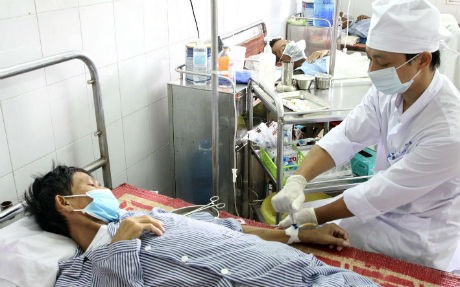 Society
Society

All people who suffer from life-threatening diseases will be eligible for palliative care, with the care beginning as soon as their diseases are detected, due to a change in a national guidance on palliative care.
 |
| A doctor examines an HIV patient at the Việt Nam-Czech Friendship Hospital in the northern port city of Hải Phòng. — VNA/VNS Photo Dương Ngọc |
HÀ NỘI — All people who suffer from life-threatening diseases will be eligible for palliative care, with the care beginning as soon as their diseases are detected, due to a change in a national guidance on palliative care.
Lương Ngọc Khuê, head of the Department of Medical Examination and Treatment under health ministry made the statement on Thursday during discussion on amendments to the guidance.
According to the World Health Organisation, palliative care is an approach that improves the quality of life of patients with life-threatening illness, through the prevention and relief of suffering by means of early identification and treatment of pain and other problems.
In 2006, with assistance from national and international experts, the health ministry issued guidance on palliative care for cancer and AIDS patients. Khuê said the guidance was a legal basis and reference point for healthcare workers to deliver proper care.
“So far, hundreds of doctors and nurses have undergone palliative care training and thousands of patients have received improved care in the last stage of their life,” Khuê said.
The updated document expands the subjects of the specialised medical and nursing care to all people with life-limiting illnesses.
It also encourages the building of multi-component groups, which include medical staff, families, social workers and volunteers, to care for patients. Palliative care can take place at hospitals, at home and within the community.
Eric Krakauer, an expert from the World Health Organisation, said the therapy helps reduce pain and should be incorporated into primary and comprehensive healthcare.
According to Việt Nam Administration of HIV/AIDS Control under the Ministry of Health, by May this year, Việt Nam had more than 209,000 people living with HIV.
In the first five months of this year, more than 1,900 people infected with the HIV virus contracted AIDS.
The first five month of this year saw 3,546 new HIV cases and 641 HIV-related deaths, deceases of 11 per cent and 34 per cent respectively compared with the same period last year.
The administration also reported that only about 50 per cent of people with HIV in Việt Nam have health insurance cards, with some not buying the insurance as they are afraid of discrimination, others being unable to afford it and some lacking necessary personal legal documents.
People living with HIV/AIDS in Việt Nam used to receive assistance from international organisations to cover medical costs and medicines. Most of the assistance was cut when Việt Nam became a middle-income country.
In response, Prime Minister Nguyễn Xuân Phúc asked localities and central agencies to arrange funding to buy health insurance for all people living with HIV. — VNS




